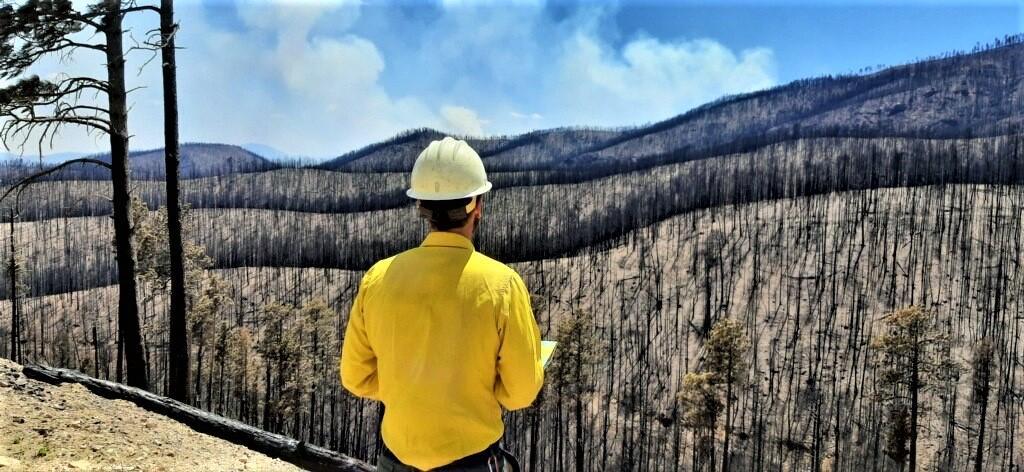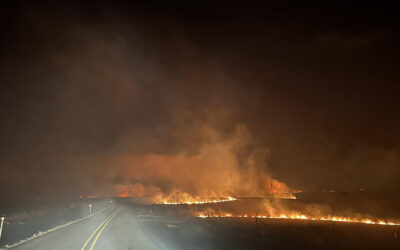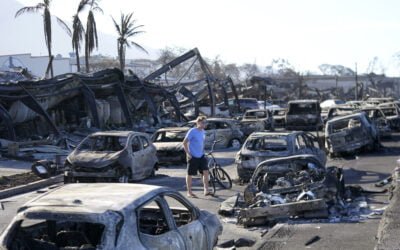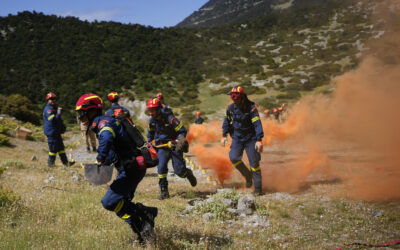
Photo: Inciweb / BAER Specialist Micah Kiesow Assessing Soil Burn Severity in Tecolote Creek Headwaters from Vantage Point within Hermits Peak Burned Area
Maya Hilty – The Santa Fe New Mexican
Apr. 21—As Brandon Glenn hiked through a light, open area of the Santa Fe National Forest northeast of the city Thursday morning, he paused and bent over a circle of burned earth about six feet in diameter, skimming the back of his hand over the ashes.
Cold.
Although the U.S. Forest Service recently has detected no heat from piles of downed trees burned across nearly 1,000 acres of Pacheco Canyon and Hyde Park this winter, the agency has not yet declared the burns “out.”
Crews will continue to monitor piles from the ground until all remaining patches of snow in the burn units have melted. Then thermal imaging from the air — either from a plane or drones — will confirm no sources of heat remain, said Glenn, the Española Ranger District fire management officer.
Requiring district rangers to use thermal imaging to back their determinations of whether prescribed fires are out is just one of a host of changes made to Forest Service procedures when they were overhauled in 2022 following the ignition of the largest wildfire in state history.
That year, Forest Service Chief Randy Moore ordered a 90-day pause on prescribed burns to review fire programs across the country after two escaped burns northwest of Las Vegas, N.M., merged to create the devastating, 341,000-acre Hermits Peak/Calf Canyon Fire.
Prescribed burns have been hindered for several years in Northern New Mexico because of a few factors: the 2022 pause; an earlier injunction on burns to study potential effects on the Mexican spotted owl, a threatened species; and suboptimal moisture levels in fuels, from needles to logs, which must meet certain standards to perform what are known as “broadcast burns” — fires that run freely across the landscape within containment lines.
This year, however, was a “really good year” for burning piles, with “big benefits” for reducing fuel loads, he said.
After an early January snowstorm, Forest Service crews drove into the Santa Fe National Forest in trucks and utility task vehicles and then snowshoed through the hills, across two to three feet of snow, to ignite thousands of piles. The piles burned for about 16 days over six weeks from late January to early March, Glenn said.
Forest Service contractors had built the piles in 2022, thinning smaller trees (no more than 8 inches in diameter) and heaping their wood into piles about six feet across and six or more feet tall. The contractors built up to 20 piles per acre, Glenn said.
After the burn, Forest Service crews regularly monitored the piles from the ground, either manually feeling for heat or using handheld infrared cameras, and mixed dirt or snow into the piles when necessary, Glenn said.
In mid-March, a plane fixed with an infrared camera detected heat in one pile. The following day, crews checked the pile, which was covered in three inches of fresh snow and was no longer smoldering. A second flight March 20 detected no heat from any of the piles, Glenn said.
Aerial thermal imaging is extremely sensitive — it can flag very small spots of heat — but it will not detect embers smoldering underneath snow, Glenn said. That’s why his agency will request another flight when snow in the burn areas has fully melted.
Thermal imaging isn’t new; the Forest Service has been using drones for about five years and is moving toward establishing full-time drone crews, he added. But new requirements since 2022 have called for more frequent drone or plane flights. Three years ago, Santa Fe National Forest leaders probably would not have requested another flight over the Pacheco Canyon and Hyde Park burns, Glenn said.
The U.S Forest Service has implemented a host of other changes since 2022.
Burn plans must incorporate more modeling from drought monitoring and forecasting websites. Forest Service leaders, including Santa Fe National Forest Supervisor Shaun Sanchez, also must approve any new or continued fires every 24 hours in case conditions change.
Another big change has been increased collaboration with the public and local leaders, Glenn and Forest Service spokeswoman Claudia Brookshire said.
“Every time we do a prescribed fire project now, we are going into communities and we’re really talking a lot about what we’re doing … How many acres a burn’s going to be, where it’s going to be located, what communities we’re protecting by reducing these hazardous fuels,” Brookshire said. “There was a lot of transition after Hermits Peak/Calf Canyon, so I feel like now we’re at a place where we have built up a team and have the staff to be able to do more of that outreach.”
Public meetings haven’t been easy; some have been “pretty contentious,” Glenn said, acknowledging many people have grown wary of prescribed burns since the historic blaze.
“I understand the last image in their head is the pictures of what happened during HPCC, and having a little bit of empathy to their situation, I think, goes a long way,” he said. “We can help people understand that what we’re doing is to help prevent that.”
Because of the unpredictable nature of fire, “I don’t think you’re ever going to be able to 100% guarantee that prescribed fire won’t get out of lines and get out of control,” he said. “But we’re way behind on trying to catch up with the accumulation of fuels we’ve had over the last 100 years.”
He added, “A lot of times, I think people see the woods and they think that’s natural, but we’ve been suppressing fire for so long that it’s not as natural as what we think it is.”
Traditionally, pine stands burn every seven to 25 years, depending on their location, he said.
“There are those folks that don’t want any burning going on, but I think a lot of the public realizes that this stuff needs to happen, or what happened [with the Hermits Peak/Calf Canyon Fire] could happen with a natural fire here,” Glenn said. “So the work needs to get done.”
___
(c)2024 The Santa Fe New Mexican (Santa Fe, N.M.)
Visit The Santa Fe New Mexican (Santa Fe, N.M.) at www.santafenewmexican.com
Distributed by Tribune Content Agency, LLC.




